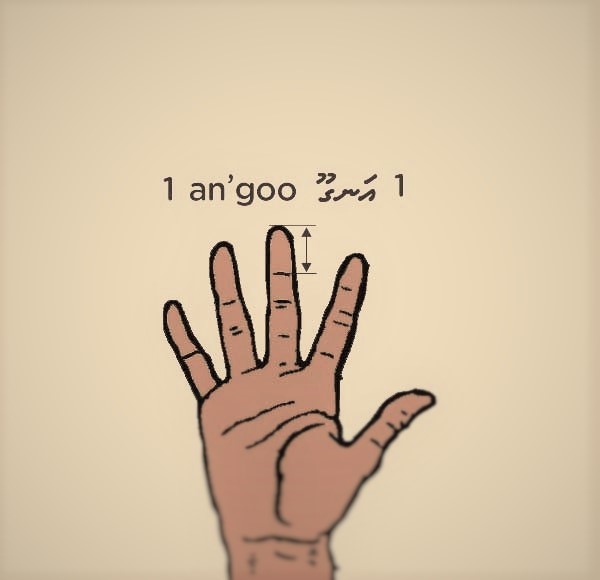
Measure is what controls the proportion, form and order of buildings. Architecturally, spaces are determined in relation to man himself. Thus, traditionally, most measurements are based on humans, such as spans and cubits. The average Maldivian is a bit shorter than Europeans though tall people are seen in every island. Except for height, there are few, if any, physical differences between the Middle East Aryans and the Maldivians, in terms of proportion. This is to be contrasted with East Asians whose arms are legs are slightly shorter compared to their torso length.
The following list of traditional measurements of length is derived from Vanavaru dated 15th March 1995 by Hassan Ahmed Maniku, an eminent historian.
| Measure | Definition |
|---|---|
| An’goo | Measure of length equal to 1.125 inches (28.575 mm). 8 an’goo is equal to one kaivah, and 16 an’goo is equal to one muh (cubit). 24 an’goo is equal to one riyan. |
| An’goofura | Length of an an’goo |
| Bama | A lineal measure equal to 72 inches (1828.8 mm). It is also equal to 2 gazu or 4 muh. 880 bama is equal to one mile. This word is also pronounced as boma. |
| Bareedhu | A measure of distance equal to 46.54 miles (74.9 km). |
| Buraalau | Graduations on the sounding line used for measuring the depth of water. It is equal to one inch. |
| Fadiyaarugey riyan | This was a measure of length used from very old times to measure land. It is still found in old documents. It is equal to 7 feet and 2.22 inches (2199 mm). Also called Thinriyan Ashagoo Bama. |
| Gama | Another word for riyan |
| Gavi | Originally a measure of distance equal to 5600 yards (5121 m). It is equal to about 3.18 miles. Now this term is used to mean an indefinitely long distance. |
| Gazu | A lineal measure equal to 36 inches (914 mm). It is also equal to 2 muh. 1760 gazu are equal to one mile (1.61 km). See Iskandharu riyan. |
| Gunthura | A lineal measure equal to 24 an’goo or 27 inches (685.8 mm) |
| Iskandharu-Riyan | Measure of length attributed to Sultan Ibrahim Iskandar I (1658–1687). It is equal to 36 inches (914 mm). 2 Iskandar riyan are equal to one bama. 2 muh are equal to one iskandaru riyan. In later times this name was superseded by the word gazu. |
| Kaalhagu | A measure of length equal to 0.375 feet (0.114 m). 2400 kaalhagu is equal to one kaalhu. |
| Kaalhu | A measure of length equal to 900 feet (274.32 m). It is also equal to 2400 kaalhagu. |
| Kaivaiy | The span. In Maldives it is take to be equal to 9 inches (228.6 mm). This is equal to 8 an’goo and 2 kaivaiy is equal to 1 muh. |
| Koas | A measure of distance equal to 2 nautical miles (3.7 km). |
| Kolhithila | A measure of length. It is the distance between the tip of the index finger and the tip of the thumb with the fingers other than these closed. |
| Kuru-muh | Measure of length no longer in use. It is the distance between the elbow and the knuckles with the fist closed. |
| Kuru-riyan | Synonym for muh |
| Minaa | One who makes lineal measurements |
| Muh | A lineal measure. It is equal to 18 inches (457.2 mm). 2 muh are equal to 1 gazu. 16 agoo or 2 kaavaiy are equal to 1 muh. 3520 muh are equal to one statute mile (1.61 km). Also known as kuru-riyan. |
| Noolu | A lineal measure equal to 0.125 inches. This term is used in the Southern islands. See Soothu. |
| Oogu | A measure of length equal to 3.375 inches (85.7 mm). It is equal to 3 an’goo. |
| Riyan | A lineal measure equal to 27 inches (685.8 mm). It is also equal to 24 an’goo. 3 Kaivaiy is equal to one riyan. See also Gama. |
| Soothu | A lineal measure equal to 0.125 inches (3.175 mm). See also Noolu |
| Udu-bama | Measure of length equal to 90 inches (2286 mm). |
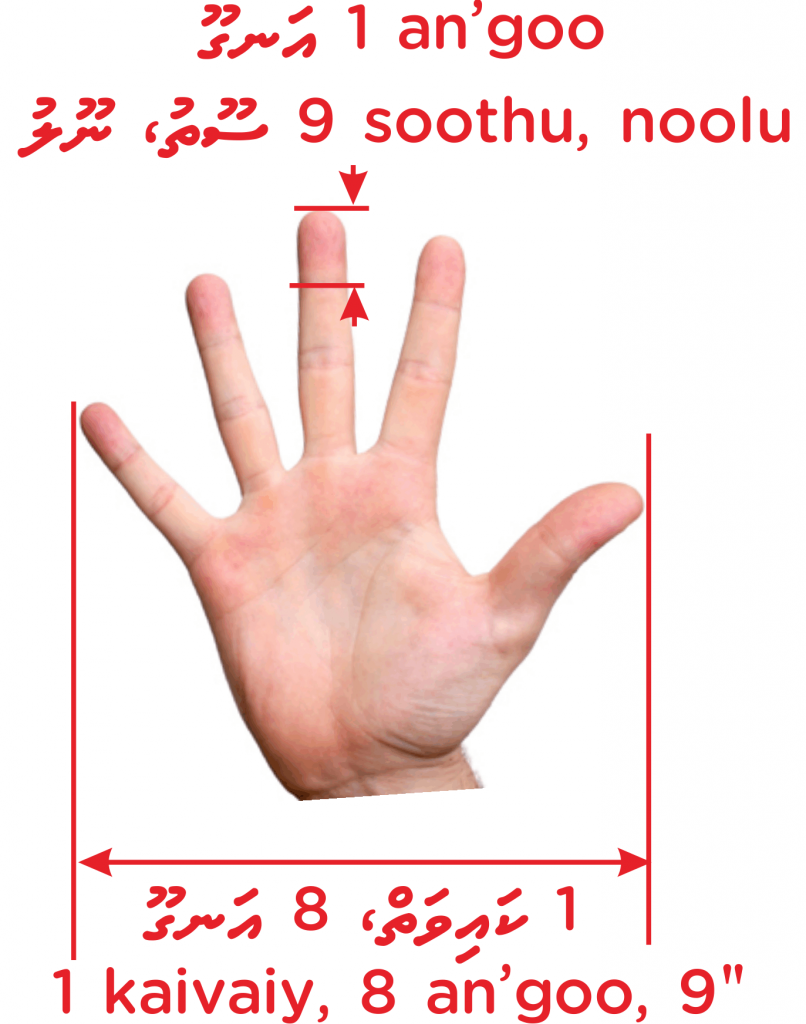 The basic unit of lineal measures in the Maldives was the an’goo, the distance between the third joint of the middle finger and its end. This length is now taken as 0.125 inches. However, an’goo is of not much use in architecture because it is so short. There are names for various multiples of an’goo: 3 an’goo is an oogu; 8 an’goo make a span (kaivaiy) and 16 an’goo make a muh and 24 an’goo make a riyan. The main measure used in architecture until very recently is the riyan.
The basic unit of lineal measures in the Maldives was the an’goo, the distance between the third joint of the middle finger and its end. This length is now taken as 0.125 inches. However, an’goo is of not much use in architecture because it is so short. There are names for various multiples of an’goo: 3 an’goo is an oogu; 8 an’goo make a span (kaivaiy) and 16 an’goo make a muh and 24 an’goo make a riyan. The main measure used in architecture until very recently is the riyan.
A riyan is of convenient size to be used in architecture. In fact, riyan is the primary lineal measure used in building houses and boats. The use of riyan is somewhat unique. In ancient Greek, Chinese and Japanese architecture, the foot is the basic unit of length. In ancient Greece, the foot (pes) is then further subdivided into 4 parts (palmus, palm width), 12 parts (uncial, inches or 1/12ths) or 16 parts (digitus, finger widths). The Japanese foot was divided into 10 parts (suns).
It is interesting to study the origin of riyan for it is a bit long (27 inches) for common use. 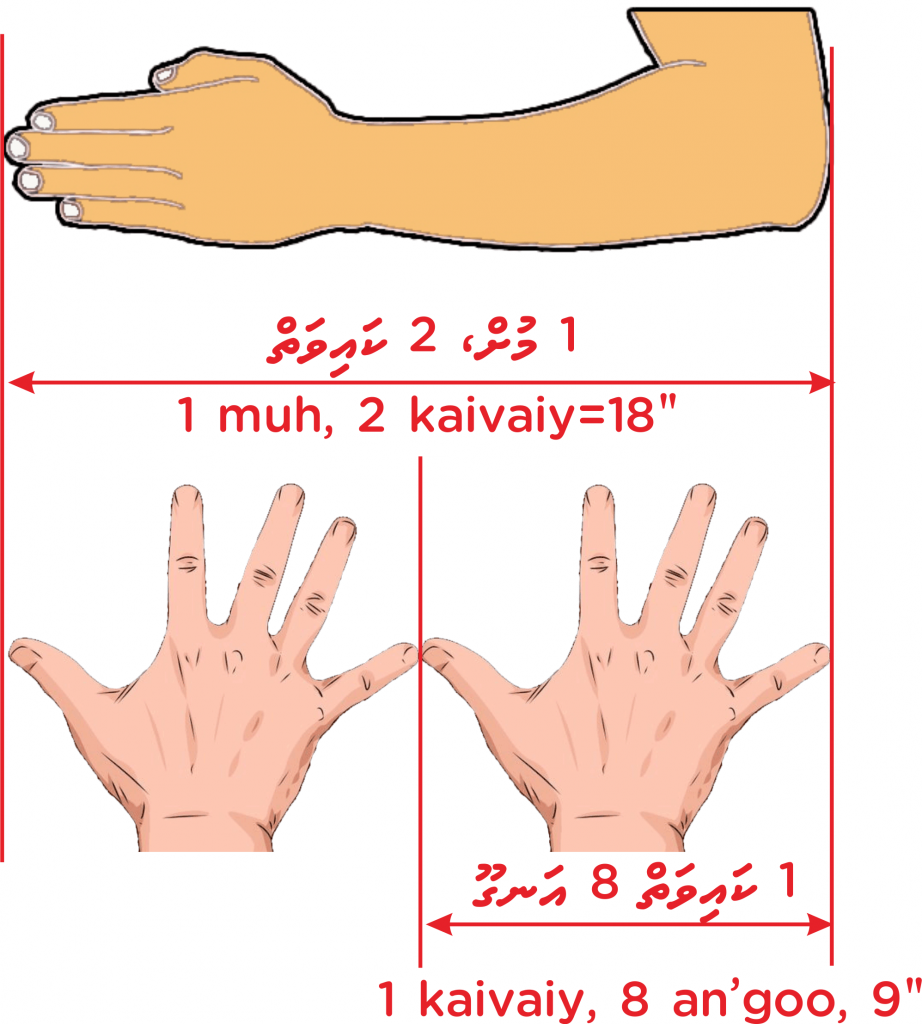 No doubt, the carpenters and the house builders must have found it very convenient. Was it derived from a Sri Lankan unit of measurement? In the Transactions of the Engineering Association of Ceylon, 1936, Ellepola notes the following on page 121:
No doubt, the carpenters and the house builders must have found it very convenient. Was it derived from a Sri Lankan unit of measurement? In the Transactions of the Engineering Association of Ceylon, 1936, Ellepola notes the following on page 121:
8 paddy seeds = 1 finger end
12 finger ends = 1 viyata (span) = 9 inches
2 viyata (spans) = 1 cubit = 18 inches
4 viyata= 1 niska
2 niska = 1 dunna (bow, dhuni in Dhivehi)
1000 dunna = 1 kosa.
What is interesting to observe from the above is that 12 finger ends is made equal to a span. In some tables, Ellepola refers to finger ends as angala (a word somewhat close to Dhivehi an’goo). This evidently means that Sri Lankan definition of finger ends is different from the Maldives’. He also notes that the space between the thumb and the forefinger stretched to the maximum extent is called vigussa. The Dhivehi word for this distance is kolhithila. The above definition of 1 kosa given above is very close to the Dhivehi definition of koas.
On page 122 of the documet noted above, Ellapola notes additional details which further give useful information about the measures used in ancient Sri Lanka.
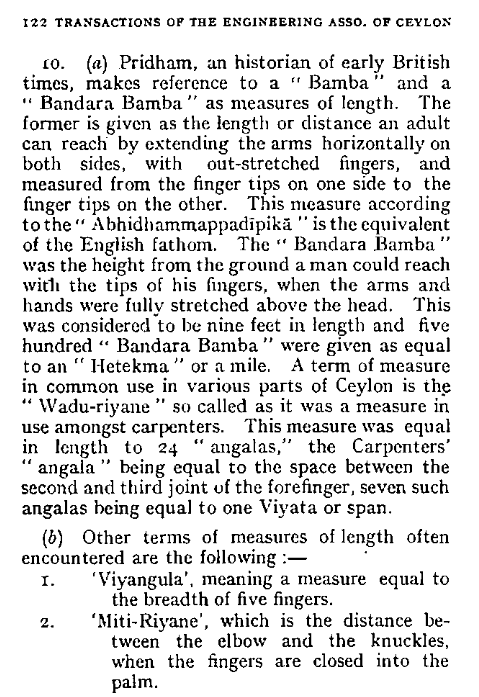
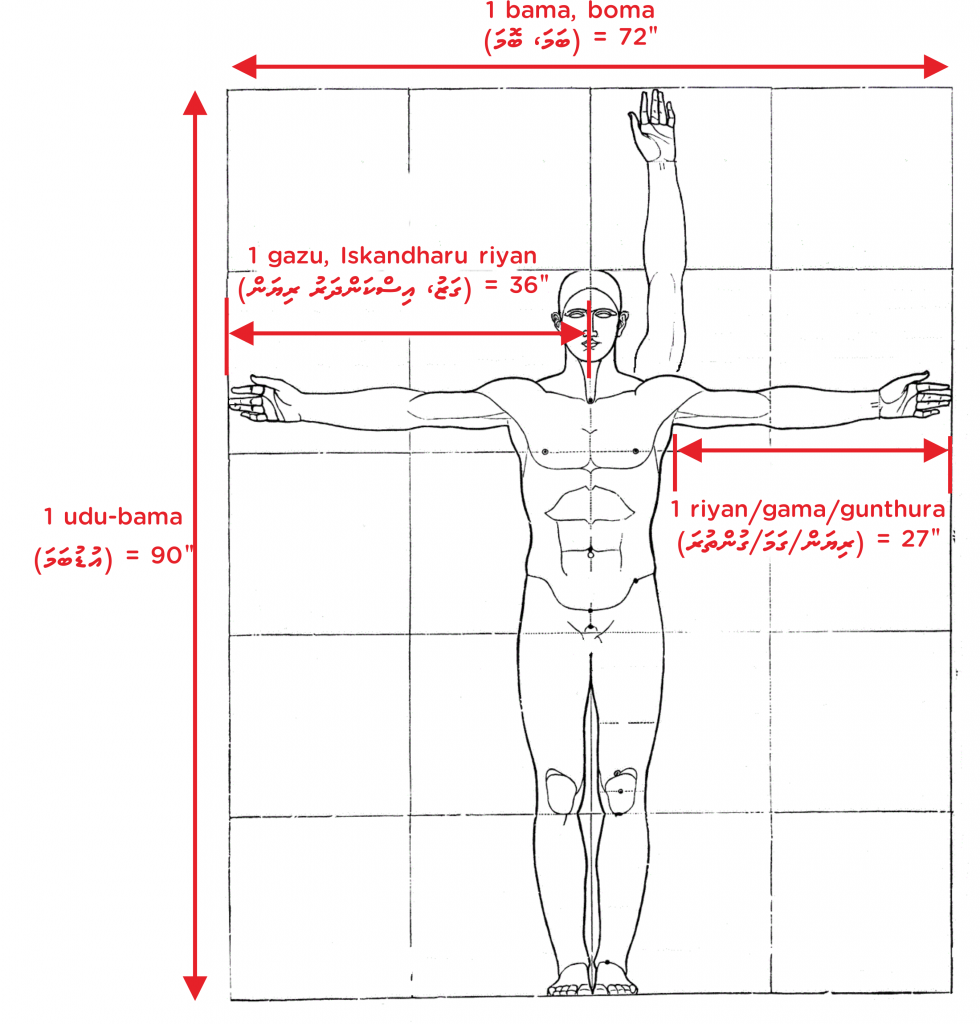 The above leaves little doubt about the equivalence of Sri Lankan bamba and Maldivian bama. The Dhivehi Udu-bama is invariably the bandara bama or the standing reach. The definitions of Miti-Riyane and kuru-muh of the Maldives are also the same. The Wadu-Riyane or Carpenter’s Riyane is 24 carpenter’s “angala” by the definition cited above. Since 7 such angala make one span which is 9 inches, then 24 angala must be (9÷7×24) or about 31 inches—4 inches longer than the Maldivian riyan. Although we can note the similarities between the riyane of Sri Lanka and riyan of the Maldives, the length is not the same. The Dhivehi riyan also has 24 an’goo, but the variation between the riyane and riyan is due to the varying definitions of an’goo; ours is shorter. The Sri Lankan definition of angala is the distance between the second and the third joint of the forefinger. This distance, or angala, is 1.286″ whereas by the definition given by Hassan Ahmed Maniku, an an’goo is 1.125″. One wonders whether these two measurements were previously the same, and that the definition of an an’goo had changed in the Maldives with the passage of time from the Sri Lankan’s. The odd length of riyan (27 inches) is by the length of a a stretched arm. Since all adult males have the riyan standard with him, it is a handy measure.
The above leaves little doubt about the equivalence of Sri Lankan bamba and Maldivian bama. The Dhivehi Udu-bama is invariably the bandara bama or the standing reach. The definitions of Miti-Riyane and kuru-muh of the Maldives are also the same. The Wadu-Riyane or Carpenter’s Riyane is 24 carpenter’s “angala” by the definition cited above. Since 7 such angala make one span which is 9 inches, then 24 angala must be (9÷7×24) or about 31 inches—4 inches longer than the Maldivian riyan. Although we can note the similarities between the riyane of Sri Lanka and riyan of the Maldives, the length is not the same. The Dhivehi riyan also has 24 an’goo, but the variation between the riyane and riyan is due to the varying definitions of an’goo; ours is shorter. The Sri Lankan definition of angala is the distance between the second and the third joint of the forefinger. This distance, or angala, is 1.286″ whereas by the definition given by Hassan Ahmed Maniku, an an’goo is 1.125″. One wonders whether these two measurements were previously the same, and that the definition of an an’goo had changed in the Maldives with the passage of time from the Sri Lankan’s. The odd length of riyan (27 inches) is by the length of a a stretched arm. Since all adult males have the riyan standard with him, it is a handy measure.
Another possible theory for the length of 27 inches for a riyan may be due to the common Arab influence. It is well known that the Arab traders were visiting the Maldives and Sri Lanka long before the Portuguese invasion of these two countries. Both in Gujarat and in Bombay, the Islamic length guz was equal to 27 inches for centuries prior to 1900 (the guz was defined to be 36 inches much later in India. The Ilahi guz which was the standardized guz by Emperor Akbar was about 33 inches). The 27-inch long riyan could have been popularized by the Bohra communities from Gujarat and Bombay, who travelled and traded with these countries. The foregoing historical note is to illuminate the cause for the popularity of riyan and for its unusual length of 27 inches. Inches were not a standard by which other measures were defined in the past; an’goo was. However, today, the dictionary definition of riyan is 27 inches, not 24 an’goo.
By the mid 1980s, the riyan was becoming less and less popular as a measure for architecture and home building. This was due to the introduction of the metric system in the 1970s. However, one still finds that the riyan is frequently used among the old generation.
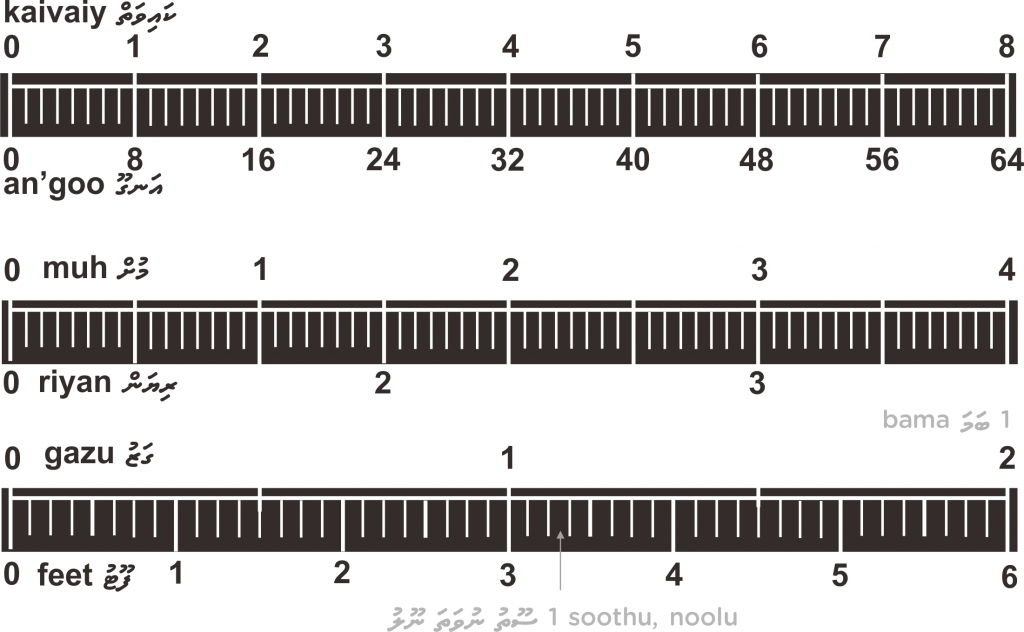
In both Greek and Japanese architecture, a module is used from which all other dimensions for architectural features are derived. In the case of Greco-Roman architecture, it is the diameter of the columns; in Chinese temples it is the width of the rafter. In Japanese room layouts, this module is the ken which is about six feet. The basic module for dimensioning wood members is, however, 4 sun which is about 121 mm [Engel, H. (1985). Measure and Construction of the Japanese House. Tokyo: Tuttle Publishing]. In Maldives, neither the riyan nor any other unit seems to have been used as a module. However, further research, especially the old mosques features need to measured to determine the existence of a module in the design of, at least, mosques.
In Part 3 of this series of articles, I discuss the types of shelters used in the Maldives and the construction of basic buildings.

Salaam,
Very interesting, thank you for such
documents.
I’m a foreigner living in Maldives for long time and daily life in island with kids (who are Maldivian themselves) brought me to do some research (school, stitching, building a house, learning dhivehi language…)
At first I knew myself only the measurement of a muh then I totally discovered many others things which made me read the full article!
Thank you
Celina
You really make it appear so easy together with your presentation but I find this matter to be really something which I believe I would by no means understand. It kind of feels too complicated and extremely extensive for me. I’m taking a look forward to your subsequent publish, I will try to get the hold of it!
Sri Lanka wadu(carpenter) riyana take as 31 inches today itself for traditional architecture(astrology)
thanks for this info